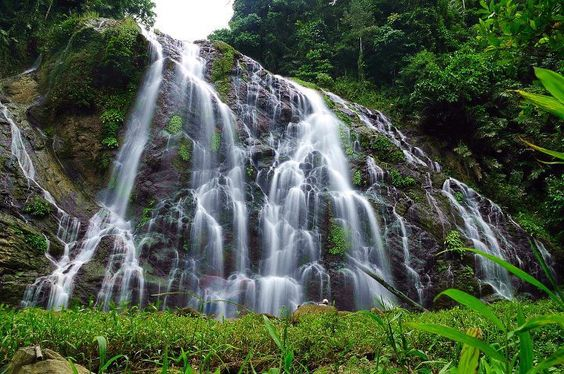Davao de Oro, officially known as the Province of Davao de Oro (Cebuano: Lalawigan sa Davao de Oro; Filipino: Lalawigan ng Davao de Oro), is a province situated in the Davao Region of Mindanao, Philippines. Its capital city is Nabunturan. It was previously part of Davao del Norte until it became a separate province in 1998.
Davao de Oro shares its borders with Davao del Norte to the west, Agusan del Sur to the north, and Davao Oriental to the east. To the southwest lies Davao Gulf. The province was originally known as Compostela Valley (often shortened to ComVal; Cebuano: Kawalogang Kompostela) from its establishment until December 2019 when a plebiscite approved the change of the province’s name to Davao de Oro.
Demographics
According to the 2015 Census data for Compostela Valley (now known as Davao de Oro), here’s a summary of the demographic information you provided:
- Age Groups and Populations:
- The age group with the highest population in Davao de Oro (formerly Compostela Valley) was individuals aged 5 to 9, with a total of 83,625 individuals.
- The age group with the lowest population was those aged 80 and over, which included 5,054 individuals.
- Age Group Aggregates:
- When grouping age categories:
- Those aged 14 and below, including infants, babies, children, and young adolescents/teenagers, constituted approximately 33.64% of the total population, amounting to 247,596 individuals.
- The age group of 15 to 64, representing the economically active population and potential workforce, made up a significant 62.13% of the population, totaling 457,371 individuals.
- The old dependent population, consisting of senior citizens aged 65 and over, accounted for 4.23% of the total population, equivalent to 31,140 individuals.
- When grouping age categories:
- Age Dependency Ratios:
- The calculated Age Dependency Ratios provide insights into the population’s dependency on different age groups:
- For every 100 individuals in the working age population, there were 54 youth dependents (aged 14 and below) and 7 aged/senior citizens (aged 65 and over).
- In total, there were 61 dependents (combining young and old-age) for every 100 of the working population.
- The calculated Age Dependency Ratios provide insights into the population’s dependency on different age groups:
- Median Age:
- The median age of Davao de Oro in 2015 was 23 years. This statistic indicates that half of the population was younger than 23, while the other half was older than 23. It provides an essential measure of the age distribution within the province.
These statistics offer a comprehensive overview of the age distribution and dependency ratios in Davao de Oro as of 2015. Please note that demographic data can change over time due to various factors, such as birth rates, migration, and aging populations, so more recent data may reveal different patterns.
| Name | City/ Municipality | Population (2020) | Population (2015) | Annual Population Growth Rate (2015‑2020) | Area (km2) | Density (2020), per km2 | Brgy count |
|---|---|---|---|---|---|---|---|
| Compostela | municipality | 89,884 | 87,474 | 0.57% | 287.00 | 313 | 16 |
| Laak | municipality | 79,744 | 73,874 | 1.62% | 768.00 | 104 | 40 |
| Mabini | municipality | 43,552 | 41,102 | 1.23% | 400.00 | 109 | 11 |
| Maco | municipality | 83,237 | 81,277 | 0.50% | 342.23 | 243 | 37 |
| Maragusan | municipality | 64,412 | 60,842 | 1.21% | 394.27 | 163 | 24 |
| Mawab | municipality | 39,631 | 37,065 | 1.42% | 136.10 | 291 | 11 |
| Monkayo | municipality | 93,937 | 94,908 | -0.22% | 609.61 | 154 | 21 |
| Montevista | municipality | 46,558 | 43,706 | 1.34% | 265.60 | 175 | 20 |
| Nabunturan | municipality, capital | 84,340 | 82,234 | 0.53% | 270.00 | 312 | 28 |
| New Bataan | municipality | 51,466 | 47,726 | 1.60% | 554.17 | 93 | 16 |
| Pantukan | municipality | 90,786 | 85,899 | 1.17% | 533.11 | 170 | 13 |
| Davao de Oro Total | 767,547 | 736,107 | 0.88% | 4,560.09 | 168 | 237 | |
Economy
| Age group | Population (2015) | Age group percentage |
|---|---|---|
| Under 1 | 15,546 | 2.11% |
| 1 to 4 | 68,027 | 9.24% |
| 5 to 9 | 83,625 | 11.36% |
| 10 to 14 | 80,398 | 10.92% |
| 15 to 19 | 73,852 | 10.03% |
| 20 to 24 | 68,772 | 9.34% |
| 25 to 29 | 62,508 | 8.49% |
| 30 to 34 | 51,048 | 6.93% |
| 35 to 39 | 45,658 | 6.20% |
| 40 to 44 | 41,415 | 5.63% |
| 45 to 49 | 38,461 | 5.22% |
| 50 to 54 | 31,715 | 4.31% |
| 55 to 59 | 25,403 | 3.45% |
| 60 to 64 | 18,539 | 2.52% |
| 65 to 69 | 12,191 | 1.66% |
| 70 to 74 | 8,220 | 1.12% |
| 75 to 79 | 5,675 | 0.77% |
| 80 and over | 5,054 | 0.69% |
| Total | 736,107 | 100.00% |
| Youth Dependency Ratio: 54.13Old Age Dependency Ratio: 6.81Total Dependency Ratio: 60.94Median Age: 23.39 | ||
Tourism
Compostela Valley, often overlooked by tourists, holds potential for eco-tourism and outdoor enthusiasts. Its lush forests, serene lakes, and mining heritage offer unique attractions for travelers seeking off-the-beaten-path experiences.
Visitors to Compostela Valley can explore its natural wonders, learn about its mining history, and savor local cuisine. The province’s potential as a nature-based destination is an exciting discovery for those seeking tranquility amidst unspoiled landscapes.





